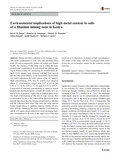| dc.contributor.author | Maina, DM | |
| dc.contributor.author | Ndirangu, DM | |
| dc.contributor.author | Mangala, MM | |
| dc.contributor.author | Boman, J | |
| dc.contributor.author | Shepherd, K | |
| dc.contributor.author | Gatari, MJ | |
| dc.date.accessioned | 2017-05-16T07:01:58Z | |
| dc.date.available | 2017-05-16T07:01:58Z | |
| dc.date.issued | 2016 | |
| dc.identifier.citation | Environ Sci Pollut Res Int. 2016 Nov;23(21):21431-21440. Epub 2016 Aug 9. | en_US |
| dc.identifier.uri | https://www.ncbi.nlm.nih.gov/pubmed/27507141 | |
| dc.identifier.uri | http://link.springer.com/article/10.1007/s11356-016-7249-1 | |
| dc.identifier.uri | http://hdl.handle.net/11295/100920 | |
| dc.description.abstract | Mining activities contribute to an increase of specific metal contaminants in soils. This may adversely affect plant life and consequently impact on animal and human health. The objective of this study was to obtain the background metal concentrations in soils around the titanium mining in Kwale County for monitoring its environmental impacts. Forty samples were obtained with half from topsoils and the other from subsoils. X-ray fluorescence spectrometry was used to determine the metal content of the soil samples. High concentrations of Ti, Mn, Fe, and Zr were observed where Ti concentrations ranged from 0.47 to 2.8 %; Mn 0.02 to 3.1 %; Fe 0.89 to 3.1 %; and Zr 0.05 to 0.85 %. Using ratios of elemental concentrations in topsoil to subsoil method and enrichment factors concept, the metals were observed to be of geogenic origin with no anthropogenic input. The high concentrations of Mn and Fe may increase their concentration levels in the surrounding agricultural lands through deposition, thereby causing contamination on the land and the cultivated food crops. The latter can cause adverse human health effects. In addition, titanium mining will produce tailings containing low-level titanium concentrations, which will require proper disposal to avoid increasing titanium concentrations in the soils of the region since it has been observed to be phytotoxic to plants at high concentrations. The results of this study will serve as reference while monitoring the environmental impact by the titanium mining activities. | en_US |
| dc.language.iso | en | en_US |
| dc.publisher | University of Nairobi | en_US |
| dc.rights | Attribution-NonCommercial-NoDerivs 3.0 United States | * |
| dc.rights.uri | http://creativecommons.org/licenses/by-nc-nd/3.0/us/ | * |
| dc.subject | Enrichment factors; Environmental impacts; Human health; Metal contaminants; Subsoil; Topsoil | en_US |
| dc.title | Environmental implications of high metal content in soils of a titanium mining zone in Kenya. | en_US |
| dc.type | Article | en_US |



